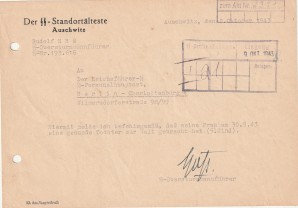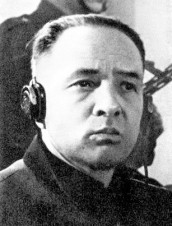SALE-RUDOLF HÖSS DOCUMENT SALE
Stock No. 68951
Product Information
Out of Stock
VERY RARE; letter about the notification of his 5th child to the SS-Personalhauptamt,reichsfuhrer ss (HIMMLER) issued Auschwitz, October 2, 1943, with SS-Personalhauptamt receipt and file stamp, SIGNED BOLD BLK INK HÖSS, FINE CON. 6X8 IN. SS OBERSTURMBANNFUHRER RUDOLF HÖSS
LIFETIME GUARANTEE OF AUTHENTICITY
Finding a Rudolf Hoess signature is extremely difficult. A very rare document and signature!
On 1 May 1940, Höss was appointed commandant of a prison camp in western Poland, a territory Germany had incorporated into the province of Upper Silesia. The camp was built around an old Austro-Hungarian (and later Polish) army barracks near the town of Oświęcim; its German name was Auschwitz. Höss commanded the camp for three and a half years, during which he expanded the original facility into a sprawling complex known as Auschwitz-Birkenau concentration camp. Höss had been ordered “to create a transition camp for ten thousand prisoners from the existing complex of well-preserved buildings,” and he went to Auschwitz determined “to do things differently” and develop a more efficient camp than those at Dachau and Sachsenhausen where he had previously served. Höss lived at Auschwitz in a villa with his wife and five children.
The earliest inmates at Auschwitz were Soviet prisoners-of-war and Polish prisoners, including peasants and intellectuals. Some 700 arrived in June 1940, and were told they would not survive more than three months. At its peak, Auschwitz comprised three separate facilities: Auschwitz I, Auschwitz II-Birkenau and Auschwitz III-Monowitz. These included many satellite sub-camps, and the entire camp was built on about 8,000 hectares (20,000 acres) that had been cleared of all inhabitants.Auschwitz I was the administrative centre for the complex; Auschwitz II Birkenau was the extermination camp where most of the murders were committed; and Auschwitz III Monowitz was the slave-labour camp for I.G. Farbenindustrie AG, and later other German industries. The main purpose of Monowitz was the production of buna, a form of synthetic rubber.
Mass murder
In June 1941, according to Höss’s trial testimony, he was summoned to Berlin for a meeting with Himmler “to receive personal orders”.Himmler told Höss that Hitler had given the order for the “Final solution”. According to Höss, Himmler had selected Auschwitz for the extermination of Europe’s Jews “on account of its easy access by rail and also because the extensive site offered space for measures ensuring isolation”. Himmler described the project as a “secret Reich matter” and told Höss not to speak about it with SS-Gruppenführer Richard Glücks, head of the Nazi camp system run by the Death’s Head Unit. Höss said that “no one was allowed to speak about these matters with any person and that everyone promised upon his life to keep the utmost secrecy”. He told his wife about the camp’s purpose only at the end of 1942, since she already knew about it from Fritz Bracht. Himmler told Höss that he would be receiving all operational orders from Adolf Eichmann, who arrived at the camp four weeks later.
Designed by Website Designers Nottingham | Powered by Wordpress






